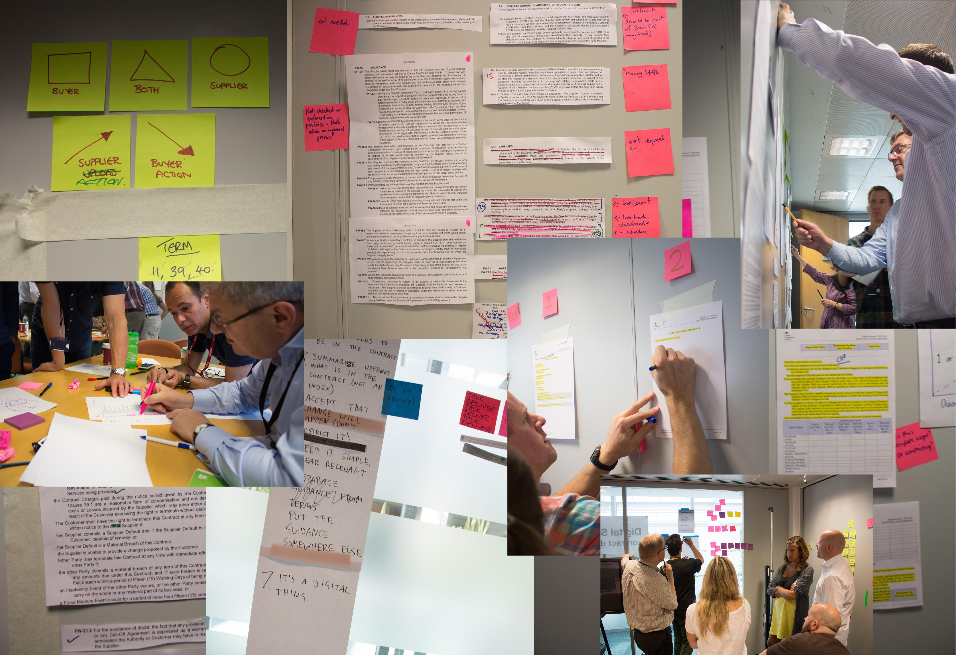In my last blog post, Redesigning Digital Services: Creating simpler and clearer contracts, I talked about the user need for plain English in government contracts. We know that the majority of buyers and suppliers who read the procurement documentation aren’t legal professionals so we’d like to make our contracts reflect this.
Since my post, we’ve held two further contract design workshops and our multidisciplinary team has used the findings to start to redesign the Digital Services contract. So far we’ve reduced the number of words by over 40%, without reducing the material content. We’re hoping to reduce this even further for the final version of the contract.
Making contracts simpler
As well as drafting in plain English and removing unnecessary content we’re aiming for a 2 line limit on sentences, as advised by Clarity International. This significantly increases the ease of understanding and reduces reading time.
Top level summaries
Insights from user research showed that buyers and suppliers need easy access to important contractual information, without having to search through the entire contract. To meet this need we’ll provide a summary at the start of the contract, highlighting the main points.
Open and transparent contracts
In line with the Procurement Policy Note 13/15 we want to make government contracts more open. This will mean that the data in a contract, such as details of the goods and services being bought and total value of the award, can be more easily disclosed in a reusable and machine-readable format. Data held within the contract will align with the Open Contracting Data Standard schema.
More digital, less documentation
To reduce the length of the contract, we’d like to host ‘boilerplate’ clauses online. These are the standard clauses that don’t change. We can then link to them from the buyer and supplier-specific contract, meaning that we publish them once, rather than reproducing them for every contract that’s created.
We’re also looking at making the process less complicated by automatically filling out parts of the contract using the details defined in the Request for Proposal (RFP) stage. We’ve started developing a prototype of the RFP process that will sit within the Digital Marketplace. We’ll be looking to link this with the creation of the call-off contract, following award. We intend for this to be in plain English too.
Beyond the Digital Services framework
Although we’re concentrating on redesigning contracts for the Digital Services framework, the wider opportunities within government legal documents are significant.
They include:
Use of images
As well as communicating in plain English to meet contract users' needs, we think there are instances when images would help users to understand contractual rights and obligations. During the design workshops we started to explore the use of visual representations, for example diagrams and icons, to communicate contractual elements such as rights, obligations, timelines and dates.
Making documents consistent
We’d like to help other commercial and procurement people in government to draft contracts in plain English. This would help us implement a consistent approach for all model government contracts and standard procurement templates.
Drafting contracts collaboratively
In his blog post titled ‘A Modern Toolchain for Contract Lawyers’, lawyer and technology expert, Sol Irvine notices an interesting parallel between contract development and software development. He says:
A contract has a lot in common with software code. Both are text files, or collections of text files, that follows a tight set of conventions. Both require tools that allow authors to create new text files while encouraging (or enforcing) those conventions.
Both require tools that enable multiple authors to collaborate on changes without losing the document’s history. Both require tools that enable multiple authors to annotate documents, and engage in in-line debate about specific changes.
We’d like to explore this parallel further. One possibility is to introduce digital tools and techniques. This could make it easier for contract drafters in government to collaborate on possible variations to standard clauses, in a way that’s controlled and auditable by the contract owners.
We believe that open, digital and visual contracts, which are easier and faster to create and implement, are needed to support building better services across government. We’ll continue to work closely with service delivery teams in departments, our suppliers, and beyond. We’ll blog regularly about what we are learning along the way.
